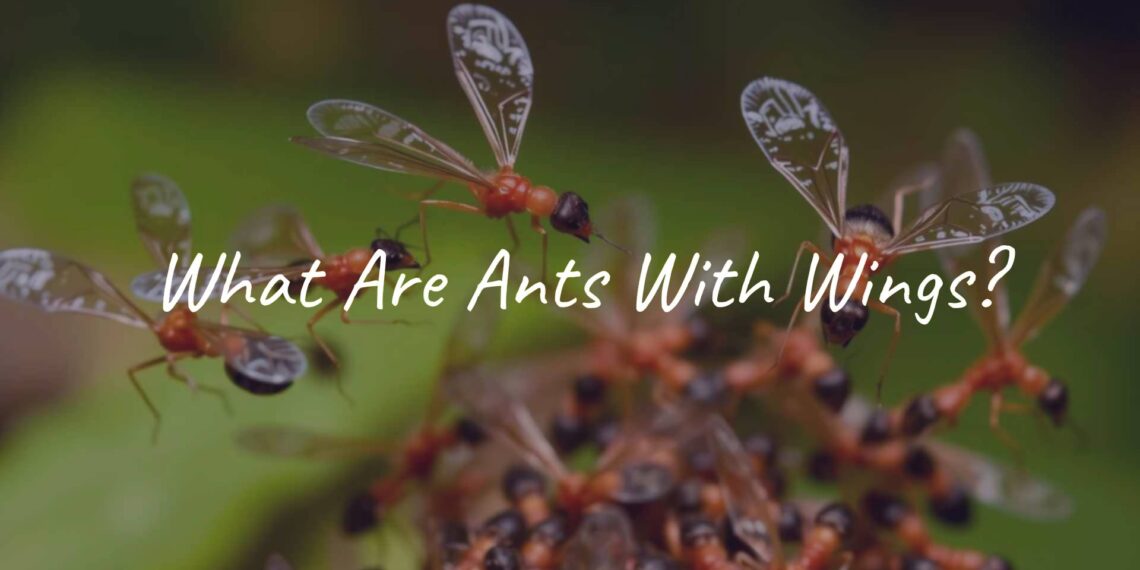Winged ants can come as a surprise, but they are just normal ants at a certain part of their life. Most ants you see are wingless workers, busy searching for food. At certain times of the year-especially during warm, damp weather-you’ll spot a group of ants with wings. These are often called alates, swarmers, or reproductives, and their job is to help the species continue.

Unlike the worker ants, these winged ants are the colony’s adults ready to mate: virgin queens and males. Their appearance means the colony is ready for a nuptial flight, a major event where these ants leave to mate and start new colonies. Though they might look different, they’re simply a normal part of the ant’s life cycle.
How Do Ants Get Wings?
Wing growth in ants is a result of the colony’s social structure and caste system. Each ant has a role: the queen lays eggs, while the female workers (who are sterile) take care of the queen, larvae, and collect food. Most eggs become wingless workers.
When the colony is developed enough and conditions are right, the queen produces new types of ants-virgin queens and males-who have wings. These ants are prepared for reproduction and stay in the nest until the right signals from their environment tell them it’s time to leave and start the nuptial flight.

Comparing Winged Ants and Regular Ants
The main difference is, of course, the wings. Regular ants you see crawling are infertile female workers, designed for labor rather than flying.
Winged ants have some notable features:
- They have bent, or “elbowed,” antennae (which helps distinguish them from termites).
- Their waists are thin and narrow, creating a segmented look.
- Their front wings are bigger than the back wings.
These features help tell them apart from termites or other winged bugs, especially during swarm seasons.
When Do Ants Grow Wings?
Ants develop wings when their colony is mature and ready to produce new reproductive ants. This usually happens during the warmer months, often after rainfall, and is not an all-year occurrence. The timing helps ensure the best chance for mating and starting new colonies.
The process only happens when certain weather and environmental conditions occur. When ready, these ants wait for hot, humid days-usually after rain-before leaving on their mating flight. This timing makes sure that many colonies release their winged ants at once for successful mating.
Types of Ants with Wings
Winged ants are not a special species-they are simply a temporary form of certain ants. Among these, only queens and males grow wings, and each has its own job and appearance.
For example, in the UK, the most commonly seen winged ants are black garden ants (Lasius niger). Red ants (Myrmica rubra) also produce winged forms. The type of winged ants you see will depend on local species.
Male vs Female Winged Ants
You’ll notice size differences in a swarm:
- Female (Virgin Queens): Larger, can be up to 15mm long, and built to start a new colony.
- Males (Drones): Smaller, less noticeable, and only around to mate with queens.
Both sexes have wings for flight, but the queen is bigger for her future role.
Queens, Males, and Workers
Ant colonies are organized into three groups, or “castes”:
- Queens: Fertile females who start and maintain the colony. They begin life with wings, mate, lose their wings, then lay eggs for years-sometimes over a decade.
- Males: The winged males are simply there to mate. They live short lives and die quickly after mating.
- Workers: Infertile females that don’t have wings. They gather food and maintain the nest. Winged workers are very rare.
Winged males and queens appear only when the colony is ready to reproduce and grow.
Can Red and Black Ants Fly?
Yes, both kinds can have winged forms for mating flights. In Britain, black garden ants are the most familiar, but red ants also have flying forms. The species you see depends on your local environment. Both need certain weather to fly-mostly warm, calm days.
Why Do Ants Have Wings?
Wings are not just for show-they are necessary for ant survival and spreading to new places. Winged ants can fly away from their original colony to find a mate and a new home, helping keep the species diverse and healthy.
Without wings, new colonies would always be close to their parent nest, raising the risk of inbreeding and reducing survival chances. Flight lets new queens and males reach different places, boosting genetic variety.
The Job of Winged Ants
Winged ants have one task: to reproduce. Males exist to mate with queens. Virgin queens, after mating, are responsible for starting new colonies.
These ants stay in the nest until the right weather sends them off for their mating flight. The event lets the colony spread out and keeps its population from getting too crowded, helping ants populate new areas.
What Is the Nuptial Flight?
The nuptial flight is when thousands of male and queen ants fly out of their nests together to mate and start new colonies. This synchronized event helps with:
- More Mating Chances: Swarming together means more possible partners.
- Mixing Genes: Flight at the same time from different nests helps prevent inbreeding.
- Protection Against Predators: The large number of ants helps many survive since predators can’t eat them all.
After this flight, queens store sperm, which can last for their whole lives, letting them lay eggs for many years.

Role of Reproduction in Winged Ants
Winged ants exist for reproduction. Males live just long enough to mate, then die. Virgin queens mate during the nuptial flight, then find a spot to start a new nest, lay eggs, and care for their first workers. This challenging start is necessary for the species to spread and survive.
When and Where Do You See Winged Ants?
Winged ants are seasonal, showing up most often in warm, damp summer months, especially after rain. Their emergence follows predictable patterns and can help you understand when to expect them around your home.
What is ‘Flying Ant Day’?
“Flying Ant Day” is a common name for the mass appearance of winged ants. It’s not just a single day, however; instead, it happens over several weeks-mainly between June and September-often in short bursts. Weather, especially warmth and recent rain, is the main trigger. In cities, they may appear earlier due to the extra heat.
What Conditions Cause Swarming?
Ideal swarming weather includes:
- Warm Temperatures: Warmth triggers emergence.
- High Humidity: Damp air keeps wings from drying out and usually follows rain.
- Low Wind: Calm air makes flying and mating easier.
- Clear Weather: Ants avoid rain during the flight.
This coordination means many colonies swarm at once, with so many ants it can even show up on weather radar.
Indoors vs Outdoors: Where Do They Appear?
Winged ants can be found:
- Outdoors: Their natural setting for nuptial flights. Gardens, lawns, pavement cracks, and under stones are common places. Signs include small piles of loose soil or ants around nests. Carpenter ants appear in rotting wood.
- Indoors: Finding flying ants inside often means a nest is in or near your home. They follow heat and light, so you may see them near windows or lights. Kitchens and bathrooms are likely spots since ants are attracted to moisture and food.
What Attracts Winged Ants Into Homes?
Winged ants are looking for two things: new nesting spots and resources. Common attractants include:
- Food: Spilled sugary drinks, crumbs, or any exposed food.
- Water: Damp wood, leaky pipes, bathrooms, and kitchens offer the needed moisture.
- Nesting Sites: Especially damp or decaying wood inside the home.
- Lights and Heat: They are drawn to windows, lamps, and any warm area.
If you see them indoors, there’s likely a nest nearby.
Are Winged Ants Dangerous?
Flying ants are usually harmless. They don’t bite or sting people unless provoked. Their focus is only on mating and moving on. However:
- Bites: Most don’t bite, though carpenter and fire ants can if threatened (and fire ants can sting painfully).
- Property Damage: Flying ants don’t harm your house, but carpenter ants nesting inside wood may cause slow damage over time.
- Nuisance: Large swarms can be irritating, especially indoors or during outdoor events.
Generally, they don’t pose a risk, but carpenter ant nests inside structures should be fixed.
How to Tell Winged Ants from Termites
Telling the difference is important since termites can cause serious home damage. Here’s a simple guide:
| Feature | Winged Ants | Winged Termites |
|---|---|---|
| Antennae | Bent or “elbowed” | Straight |
| Waist | Thin and pinched | Wide, same width all along body |
| Wings | Front wings longer than hind, veined, clear | All wings same size, usually milky or opaque |
| Color | Varies-black, red, or yellow | Usually black or dark brown |

Looking closely, you can tell them apart. If you only find wings, termite wings are all one size while ant wings come in two lengths.
Does Seeing Flying Ants Mean There’s an Infestation?
Finding winged ants, especially inside, can mean there’s a nest very close by or already inside. If you see carpenter ants (especially near damp wood), there’s a high chance they’re nesting within your home. Even seeing just a few should prompt you to check, and larger numbers are definite signs a colony is active nearby.
What Happens After Winged Ants Lose Their Wings?
After the nuptial flight, life changes quickly for these ants, especially for new queens.
Why Do Female Ants Lose Their Wings?
Once a virgin queen has mated, she no longer needs her wings. In fact, wings only get in the way as she starts her new nest, so she chews them off. The lost wings won’t come back-this shows she’s now fully focused on starting her colony. Discarded wings on the ground mean new queens are looking for nesting spots.
What Happens to Queens After Mating?
Now wingless, the queen finds a safe place, often underground or in wood, and begins laying eggs. She doesn’t eat for weeks, living off her stored fat and sometimes the muscles she used to fly. She takes care of the first group of eggs, raising them into workers who’ll take over nest duties so she can keep laying eggs. The sperm she received from mating lasts her whole life-up to 15 years or more for some. Males, meanwhile, die shortly after mating.
How to Deal With and Prevent Winged Ants at Home
Flying ants in the house are mostly a bother, but can mean a nest is nearby. Quick action and prevention are both needed.
Quick Control Methods
- Vacuum: Suck up the ants quickly and dispose of the bag or canister outside.
- Soapy Water: Mix dish soap and water, then spray the ants. The mix kills them on contact.
- Sticky Traps: Place near windows and doorways to catch ants coming or going.
- Ant Bait: Use bait stations near sightings. Ants bring poison back to the nest, which can eliminate the colony over time.
Find where they’re coming in by looking for ant lines, sawdust, or cracks near doors and windows.
Prevention Tips for Indoors and Outdoors
- Seal Gaps: Use caulk or weather stripping on cracks and small openings.
- Keep Things Clean: Wipe up food and crumbs, and store food in tightly closed containers. Take out garbage promptly.
- Fix Water Problems: Repair leaks and keep kitchens/bathrooms dry. Replace any rotting wood.
- Yard Maintenance: Remove old wood, trim branches touching your house, and clear away things that collect moisture.
- Check Regularly: Watch for ant activity, especially in spring and summer.

When to Call Pest Control
If home methods don’t stop the problem, or if you have a large or stubborn infestation, it’s time to call a professional, especially if:
- Ants keep coming back or their numbers are high
- You see carpenter ants or signs of wood damage
- You can’t find where they’re coming from
Experts can find the nest and use strong treatments to remove the problem completely and safely.
Are Winged Ants Good for Nature?
Winged ants, and ants in general, are important for the environment. Here’s how they help:
- Soil Improvement: Their tunnels aerate dirt and help water and nutrients pass through the soil.
- Food Source: Their swarms feed birds and other animals. Swifts, gulls, and other birds eat many flying ants during their short flight season.
- Seed Spreading: Some ants help move seeds and might even assist in pollination.
- Environmental Changes: Ants shape their surroundings, making homes for other small creatures.
- Helping Other Species: Some ants protect butterfly caterpillars or other insects in exchange for food.
While their swarms might bother us, flying ants play key roles in keeping natural systems healthy.
Frequently Asked Questions about Winged Ants
Do All Colonies Produce Winged Ants?
Yes. Most mature ant colonies will produce winged ants at some point to create new nests. While a few species do things differently (like army ants, where usually only males fly), the basic system is the same across almost all types of ants.
Are Flying Ants and Alates the Same?
Yes, “alate” is simply the scientific term for a winged reproductive ant (and other insects like termites). So, “flying ant” and “alate” refer to the same ants.
How Long Do Winged Ants Live?
- Males (drones): Very short-lived. After mating, they die within a day or so.
- Females (queens): If they mate and start a colony, they can live over a decade, sometimes nearly 30 years in safe places, but their “flying” life is just a few days.
So, male winged ants have the shortest lives, and queens can live much longer-mostly underground, busy growing their colonies.
















![What to with Scrap Metal? [infographic]?](https://facts-homes.com/wp-content/uploads/2019/07/645413-POPYOV-391-120x86.jpg)





